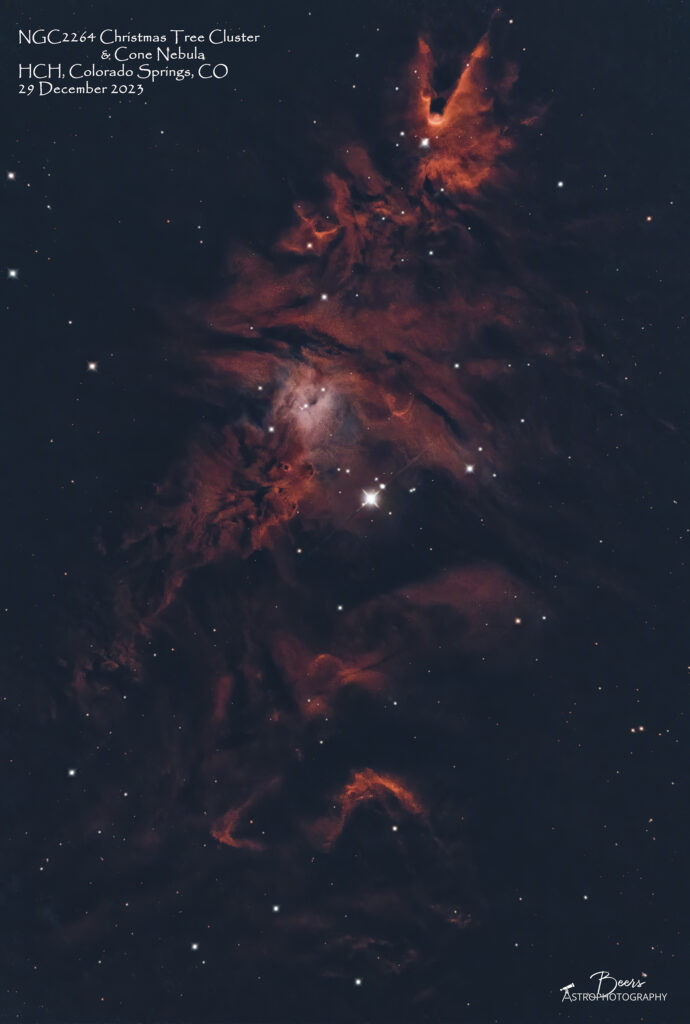
A New Years’ Day belated Christmas greeting…
You may have heard or seen NASA’s Christmas holiday-related images release stating NASA’s James Webb Space Telescope and Hubble Space Telescope have united to study an expansive galaxy cluster known as MACS0416. The resulting panchromatic image combines visible and infrared light to assemble one of the most comprehensive views of the universe ever taken. Located about 4.3 billion light-years from Earth, MACS0416 is a pair of colliding galaxy clusters that will eventually combine to form an even bigger cluster. “We’re calling MACS0416 the Christmas Tree Galaxy Cluster, both because it’s so colorful and because of these flickering lights we find within it. We can see transients everywhere,” said Haojing Yan of the University of Missouri in Columbia, lead author of one paper describing the scientific results. (Read more at: https://www.nasa.gov/missions/webb/nasas-webb-hubble-combine-to-create-most-colorful-view-of-universe/ ) That is not the same NGC2264 Christmas Tree Cluster & Cone Nebula that I captured! NASA’s “poetic license” and creative processing of NGC2264 is here: https://www.nasa.gov/image-article/telescopes-illuminate-christmas-tree-cluster/
So, off the Hubble and JWST and their space-borne views and back to earth, specifically Colorado Springs…
December has been a month of experimentation with new equipment and new software. Starting the month with the addition of the ZWO EAF autofocuser and ending the month with the Rainbow Astro RC-300 mount, then upgrading SGPro and PHD2 just to throw a few more variables into the equation! The final imaging session of the year – 29Dec2023, capturing NGC2264 Cone Nebula was probably the most successful with all of the “challenges” I’d been working through mostly resolved. The result (shown below) was good but a little monotonic because of the LeXtreme filter against the 90.8% waning Gibbous moon. So, I decided to create a multi-session image with the data I’ve captured over the last two years (almost all of the data – APP will only stack 5 separate sessions).
The gallery / portfolio multi-session image and its collection notes and details are here: https://beersastrophotography.com/gallery/ngc2264-christmas-tree-cluster-cone-nebula/ A few of the individual images whose data are included in this multi-session image are shown below, giving you a feel for the variation caused by filters, dark skies, and learning what you’re doing! Ironically, the first and last images were taken exactly two years apart. December 29th seems to be the day for this image capture!
Previous images of this object (data included in the multi-session image)…
After spending an inordinate amount of time on IC443 Jellyfish Nebula during the clear nights in December 2023, I decided to spend the last clear night of 2023 on NGC2264 Cone Nebula. This was with all the “changes” that I’ve made over the last six weeks in place – new mount (RST-300), new autofocuser (ZWO EAF), new software (update to SGPro from v3.2.0.660 to v4.3.0.1265). Yes, way too many variables to change at one time!! But, during this session, they all came together just fine. The issue I had was with the autoguider – which lost connection to the camera and terminated the sequence (even though I had also figured out and implemented SGPro’s recovery mode) just before the meridian flip and for a two hour period between 0200-0400MST. Despite that data loss, I captured 81 subframes.
This image was captured from the front patio with Big Bertha (8″ R-C telescope), the ASI2400MC camera with a Field Flattener and LeXtreme light pollution filter. The LeXtreme does a great job of filtering out light pollution – both natural (90% moon) and man-made (Bortle 6 Colorado Springs skies), but also blocks much of the color by concentrating on the Ha (i.e., red) wavelength. After I processed this image, I decided to create the multi-session image above.

This was the only dark skies data I’ve captured on NGC2264. I imaged NGC2264 during both 28Jan2022 and 29Jan2022 from Mills Canyon Rim in the Kiowa National Grasslands. Both nights, NGC2264 was the second/final target in cold conditions (16deg Friday, 22 degrees Saturday) and a setting target. At the end of each session, the mount parked the telescope in RA but was “frozen” in Declination. Friday night the Beast’s battery power was drained so much that I couldn’t even power the laptop to capture calibration frames. …and based upon the number of subframe rejects, even when the mount was moving, it wasn’t operating properly! The original sequence plan executed both nights called for ISO1600; 50x300sec. The first night (28Jan2022), I captured 40x300sec with 17 rejects due to star trailing. I captured good frames 29Jan22, 0034 – 0236MST, with rejects at 0134MST and between 0236-0400MST. The second night (29Jan2022), I captured 21x300sec with 15 rejects due to star trailing. I captured good frames 30Jan22, 0132 – 0158MST, the rejects were 0204-0318MST. Only the data captured on Friday, 28Jan2022 is included in the multi-session image.

Ironically, this image was captured from the same spot (HCH front patio) on the same date (December 29th) with the same telescope (Big Bertha) two years to the day prior to the final session in this multi-session image! The differences – this was captured with the Canon EOS Ra vs the ASI2400MC, no light pollution filters (because I didn’t own any yet at that time), and a waning crescent moon (17%). Not bad for ~10 months of astrophotography experience!

